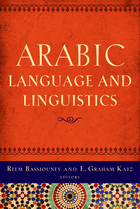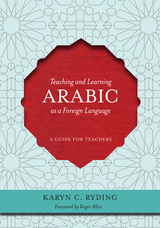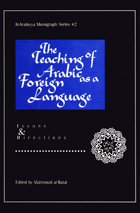
Al-'Arabiyya is the annual journal of the American Association of Teachers of Arabic and serves scholars in the United States and abroad. Al-'Arabiyya includes scholarly articles and reviews that advance the study, research, and teaching of Arabic language, linguistics, literature, and pedagogy.

Arabic, one of the official languages of the United Nations, is spoken by more than half a billion people around the world and is of increasing importance in today’s political and economic spheres. The study of the Arabic language has a long and rich history: earliest grammatical accounts date from the 8th century and include full syntactic, morphological, and phonological analyses of the vernaculars and of Classical Arabic. In recent years the academic study of Arabic has become increasingly sophisticated and broad.
This state-of-the-art volume presents the most recent research in Arabic linguistics from a theoretical point of view, including computational linguistics, syntax, semantics, and historical linguistics. It also covers sociolinguistics, applied linguistics, and discourse analysis by looking at issues such as gender, urbanization, and language ideology. Underlying themes include the changing and evolving attitudes of speakers of Arabic and theoretical approaches to linguistic variation in the Middle East.

This book offers concrete and practical ideas for implementing content-based instruction—using subject matter rather than grammar—through eleven case studies of cutting-edge models in a broad variety of languages, academic settings, and levels of proficiency.
The highly innovative models illustrate content-based instruction programs for both commonly and less-commonly taught languages—Arabic, Croatian, French, German, Indonesian, Italian, Russian, Serbian, and Spanish—and for proficiency levels ranging from beginners to fluent speakers. They include single-teacher and multi-teacher contexts and such settings as typical language department classrooms, specialty schools, intensive language programs, and university programs in foreign languages across the curriculum.
All of the contributors are pioneers and practitioners of content-based instruction, and the methods they present are based on actual classroom experiences. Each describes the rationale, curriculum design, materials, and evaluation procedures used in an actual curriculum and discusses the implications of the approach for adult language acquisition.

The first book in English on the founder of Arabic linguistic theory, this interdisciplinary collection explores the contributions to Arabic intellectual history of al-Khalil ibn Ahmad, (d. A.H. 175/A.D. 791).
Al-Khalil was distinguished in his own time as a lexicographer, phonologist, grammarian, educator and musicologist. In the Arab world, his stature is almost legendary, although information on his life, his works and his achievements is fragmented. He is remembered principally for two achievements: the creation of the first dictionary of the Arabic language (Kitab al-'ayn, "The Book of 'ayn"), and discovery of the rule-governed metrical systems used in pre-Islamic Arabic poetry. His biographers also cite publications on musical theory and have preserved fragments of his poetry. In addition to these achievements, he was also the teacher of the medieval Islamic world's most distinguished authority on Arabic grammar, Sibawayh.
Conceived as a tribute to al-Khalil’s influence on Arabic language sciences, this book provides a new and broader perspective on al-Khalil’s talents, character, and fields of interest. It should be of interest to Arabic linguists, medievalists, historians of linguistics, theoretical linguists, historians of science and scholars of medieval Arab intellectual history.

This new edition, updated and with additional exercises, equips those who work, travel, and study in Arab countries with an educated form of spoken Arabic that functions flexibly in the face of various regional colloquial variants in the Arab world.
Because the Arabic language has a number of very different spoken vernaculars, being able to speak and be understood in all Arab countries has become a challenge for English speakers. Ryding and Mehall have designed a course that teaches a standardized variant of spoken Arabic that is close to, but more natural than, the literary Modern Standard Arabic.
With a non-grammar-based approach, this book fosters communicative competence in Arabic on all levels and develops speaking proficiency without abandoning Arabic script. It has proven to be clear, effective, and relevant to the needs of Americans living and working in the Arab East. Task-based lessons feature basic dialogues between Americans and Arabs, explanations of new structures, vocabulary expansion, and exercises; and provide gradual access to the sounds and script of Arabic by emphasizing listening and reading comprehension first, then slowly adding oral exercises and activities until the student has achieved basic proficiency.
Not intended for self-instruction for beginners, Formal Spoken Arabic Basic Course with MP3 Files assumes some previous knowledge of Modern Standard Arabic, Arabic script and phonology, and previous or simultaneous instruction in orthography. This new edition includes a CD of MP3 audio exercises that are keyed to the text and drill students on listening and speaking.
Lessons cover topics including:
Heads of StateCities and CountriesOfficial TitlesGeographySystems of GovernmentLost LuggageGetting AcquaintedEstablishing Common GroundSeeking and Giving InformationPersonal Needs and FamilyHandling ProblemsEating OutBargaining and Buying

This Arabic language-learning classic is now enhanced with a bound-in CD of MP3 files. Designed to provide beginners in Arabic with maximum linguistic and cultural exposure in a short period (about 100 hours of contact time), this book consists of sixteen lessons with dialogs and exercises dealing with day-to-day scenarios: greeting people, getting a taxi, making phone calls, asking directions, discussing the weather, and effectively communicating with police and duty officers. The lessons help the reader to navigate situations at gas stations, marketplaces, restaurants, and in their own households.
Formal Spoken Arabic (FSA) is a kind of lingua franca that is more natural than speaking Modern Standard Arabic (MSA), the literary form of the language. FSA uses the shared features of the various urban colloquial dialects, defaulting to Levantive (terms common to Lebanon, Syria, and Jordan) where the spoken dialects diverge. Each lesson includes cultural notes on American-Arab interactions, notes on learner strategies for managing Arabic conversations with a limited amount of language, and grammar explanations in clear, non-technical language. Although the main dialogue for each lesson is presented in Arabic script, transcriptions are used to accelerate spoken performance. The FAST Course includes grammatical explanations, English-Arabic and Arabic-English glossaries, appendices listing common idioms, courtesy expressions and other useful terms, instructor's notes, and drills aided and accompanied by the CD.
Originally created for diplomats, this is an expanded and enhanced edition of a work originally developed by the U.S. State Department as a six-week intensive, or "FAST" (Familiarization and Short-Term) course, and is easily adaptable for students in Middle East area studies. Travelers heading for posts in the Arab world who quickly need to gain a basic ability to converse in day-to-day situations will find Formal Spoken Arabic FAST Course an invaluable companion.

This guide clearly and succinctly presents the basic tenets of teaching foreign languages specifically for Arabic teachers. Consolidating findings from second language acquisition (SLA) research and applied linguistics, it covers designing curricula, theory and methods, goals, testing, and research, and intersperses practical information with background literature in order to help teachers improve their teaching of Arabic as a foreign language (TAFL).
Karin C. Ryding, a well-regarded scholar of Arabic linguistics and former president of the American Association of Teachers of Arabic, frames the discussion with SLA literature and suggests practical and effective ways of helping students learn. Ryding discusses issues at the core of Arabic teaching effectiveness and the achievement of communicative competence, such as the teaching of pronunciation, speaking, reading, listening, and writing; teaching mixed-level classes; creative classroom organization; corrective feedback; and use of activities and exercises, with plenty of examples from Arabic and tips for teachers. She also covers materials development and proficiency testing, providing study questions and recommended readings for each chapter.
This guide, which can be used as a textbook, is the first of its kind aimed specifically at TAFL, and should be of interest to Arabic instructors-in-training, academics, graduate students, linguists, department chairs, language coordinators, and teacher trainers. It also serves as a resource for teachers of other less commonly taught languages (LCTLs), who struggle with similar issues.

In this volume leading teachers of Arabic, many of whom have written influential textbooks for advanced learners, explore the realities and challenges of teaching Arabic as a foreign language. Topics covered include the state of the Arabic teaching profession; the institutional challenges in U.S. and study-abroad programs; the teaching of various skills such as writing, reading, speaking, and listening; the varieties of Arabic and their relevance in the classroom; the uses of technology in the classroom; and testing. Published in 1995, many of the issues raised in this volume remain relevant today.
Distributed for the American Association of Teachers of Arabic
READERS
Browse our collection.
PUBLISHERS
See BiblioVault's publisher services.
STUDENT SERVICES
Files for college accessibility offices.
UChicago Accessibility Resources
home | accessibility | search | about | contact us
BiblioVault ® 2001 - 2024
The University of Chicago Press









